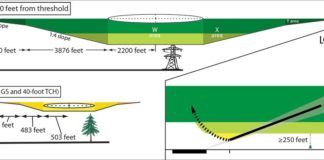One of the best things about an ILS is that you know what you’re going to get. The boundaries of TERPS criteria mean they all work pretty much the same: You fly a published altitude to intercept a glideslope, ease down through the amorphous ether toward terra firma and either land or miss.
Except for when that is so, so not the case. Take a look at the ILS Runway 16R into Reno/Tahoe (KRNO). On first glance, this is a simple ILS with the primary complication being some obvious terrain in the area. Terrain like that always warrants a close reading of the chart and its notes, usually to find the non-standard climb required if you must fly the missed. That’s not an issue in this case, but there are four other oddities to contend with—one of which is an outright error on the chart.
The Cold Equation
Let’s start with the notes. The

indicating non-standard departure (takeoff) procedures and non-standard alternate criteria are no surprise with so much rising terrain around. But what’s up with the

?
This symbol as fairly new, and it means the airport is on an FAA list of “Cold-Temperature Restricted Airports.” Google it and you’ll find an FAA document listing many airports in the U.S. (with a logical abundance in Alaska) where cold temperatures and the resulting “…anticipated errors in a barometric altimetry system could exceed the Required Obstacle Clearance.” Translation: You might be too low even with the correct altimeter setting.
Actually, it’s not as harsh as it might seem. The red flag goes up if there’s a one-percent or greater chance that sub-standard temps could put you low enough that the required obstacle clearance gets compromised. That’s not saying you’d be so low you’d hit the rocks.
Still, if the temperature at KRNO is below a not-impossible -18 degrees C, you’ll need to make a correction to the altitude you fly for some segment of the approach. The FAA documentation tells which segment might be at risk, and references AIM 7-2-3 for the ICAO Cold Temperature Errors Table. These are mostly small corrections.
The Mystery Intercept
The notes section also points out that flying this approach without a glideslope is verboten. The localizer-only approach is on a different chart. This should make the asterisk by the glideslope intercept altitude of 8500 MSL in the profile view stand out. We’re so used to an asterisk by an altitude down here denoting an extra stepdown or something else that’s “Loc-only,” but if this approach is just the ILS, what’s with the little star?
The corresponding note is an unusual one: “7400 when authorized by ATC.” That’s nice to know. It’s common to get a slightly lower intercept when in radar coverage, but 1100 feet lower? That might cause a wave of doubt right at a critical phase of the approach given the hills all around.
Don’t get too attached to this nicety, though. This type of note is being phased out. As always, if you have doubt about the altitude assignment you think you just heard, ask.
The High ILS
It’s almost a truism that you can get lower on an ILS than on the corresponding localizer-only approach. Not so in Reno-Tahoe. The ILS DA is nearly 500 feet higher. How can that be?
The obstacle clearance surfaces, which are the areas evaluated for obstacles underneath and to the sides on approach, are different shapes for an ILS versus a localizer-only. If the obstacles happen to fall in just the right locations, they can penetrate the ILS assessment areas—and require an unusually high DA—while just missing the localizer ones. Usually it’s something at the very beginning of the ILS, where the localizer approach could start a bit later with a steeper descent, or at the very end where a localizer could level off a bit high. You’ll see this a bit more often with LNAV/VNAV minimums co-charted with LNAV-only minimums.
Digging into the differences on this chart, you see that glideslope intercept is 11.1 miles from the runway, with a descent angle of 3.1 degrees. The FAF for the localizer comes later, at 7.4 miles out from the airport, presumably to get you past some object. This results in a steeper descent of 3.49 degrees to reach the runway touchdown zone.
The MDA of 1600 feet AGL is pretty high due to some closer in obstacles. This also puts the visual descent point (VDP) 4.5 miles from the runway. That makes the straight-in visibility minimums laughable. Either you have over four miles of visibility or you’re going to circle. Good thing both MDAs are the same.
The Misplaced Missed
If the VDP is over four miles north of the runway, and the ILS DA is higher, then you’ll reach that DA while still miles north of the airport. The profile view shows that pretty accurately, but the plan views on both approaches place the dotted missed-approach course south of the airport—after the runway. If you’re down there on the missed, something went seriously awry.
This is a charting error. Even chart designers make mistakes, and those mistakes can be compounded on assumptions that it was initially correct. If the dotted missed-approach path was charted on the opposite (far) side of the airport on the previous versions, it’s natural to just put in there on the next version without realizing the error. In the next amendment to this chart, that path’s position should be changed.
The beauty of standardized instrument procedure designs is that local oddities like these won’t cause you bodily harm if you follow the instructions and fly the black lines. Your responsibility includes knowing what all those instructions imply so nothing catches you flying by rote rather than the reality of the moment.
Jeff Van West admits he can get too focused on the details. Luckily, as he gets older, they’re harder and harder to see.




